Be A More Eco-Friendly Traveller With These Easy, Everyday Tips

Going to be a little honest here – I feel like our world right now is in a state of upheaval. We’re at a point where the effects of climate change are becoming irreversible. While it may seem like it’s impossible to make an impact – you’re wrong. There are so many simple ways each of us can be an eco-friendly traveller and it takes minimal effort. It’s all about good habits, slowing down and enjoying life. The best part? These are habits we can adopt at home even when we’re not travelling. Sound good?
Seriously though, this post comes from an internalized frustration of ignorance and arrogance. Am I a perfect traveller? Hell no, and I never claim to be. I’m just trying to do my best in the crazy journey called life, and help others do the same. Earth Day is a great reminder to be kind to the planet, however our efforts shouldn’t only be limited to a singular day. I think if we all just tried a little bit harder, it would make a world of difference. Without further ado…
Ways to Not Be an A*Hole to The Environment While Travelling (& at Home!)
To be honest, I think that’s really what the title of this article should be but my friends said I should tone it down a wee bit. Why a*hole? Because everyone’s got one – and we can all do our part to help!
Okay! Now onto the easy, everyday ways we can do better for the environment as we travel.

My personal favourite for being a more eco-friendly traveller – dining in!
Dine In at a Restaurant
I get it, sometimes you just want to hole up in your hotel room or hide at home and devour your delicious feast. I’ve been there, I’ve done that. Though if you’re like me, you cringe at the amount of styrofoam or plastic containers that meal comes in. Instead, get off your lazy arse and just eat in. Not only is there less waste but let’s be honest – food tastes better when it’s fresh and not once it’s arrived at your home/hotel/vehicle 10-20 minutes later.
But Lindsay, what if I can’t finish my meal? Oh, the styrofoam agony! You’ll have to do a little pre-planning, but I promise it’s worth it. 9 times out of 10 I don’t end up finishing my meal because my eyes are bigger than my belly. This is where packing a re-usable food container is key! I seriously never travel without one now. My usual go-to is a handy Pyrex container. There are also these rad divided ones which I seriously want are perfect if you pack meals often or are in need of some snack containers for epic road trips. If you’re travelling carry-on only then they can be a little heavy, however I often pack items inside to help save space and make up for the weight.
Cut Down on Your Meat & Dairy Intake
The meat and dairy industries are some of the most wasteful in the world as it emits large amounts of greenhouse gases and uses incredible amounts of water. For example, 1799 gallons of water is used to produce a single pound of beef. Why so much? It’s due to a number of factors like the livestock’s intake and the water used in the feed it eats.
Lindsay… you’re not vegan OR vegetarian. Yes, that’s true but I’m also not a person that feels it’s necessary to have meat or dairy at every meal. I minimize my impact by decreasing my intake and see it more as a treat, not a necessity nor a right. Just think of how much the impact would decrease if everyone went one day without meat or dairy? Two days? One meal a day? It all adds up if we make more educated choices.
If you are going to eat meat, then buy local. Go to a local butcher. Visit the local farmer’s market. That way you’re supporting a local establishment or family while also cutting down on transportation and other costs that come into play with the mass market.
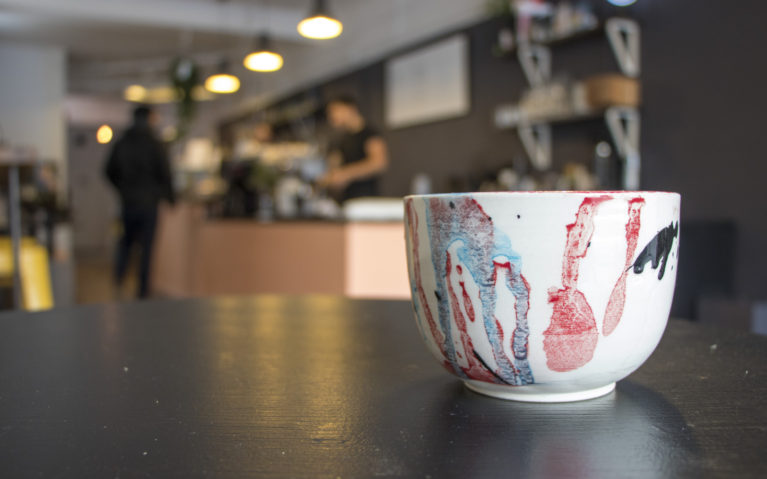
Coffee is best when it’s fresh and drank right away!
Don’t Get Your Coffee (Tea, Beverage of Choice, etc) To Go
The majority of coffee shop to-go cups are not recyclable due to the inner layer of plastic to make them waterproof. Although it’s not that we don’t have the technology to recycle them, it’s that the technology isn’t easily accessible. While Starbucks says they recycle the cups, the majority of them end up in a landfill. As for our Canadian equivalent, Tim Hortons passes the buck to the consumer rather than just making a cup that’s recyclable anywhere. The easiest way to avoid this dilemma? Enjoy your cup at the cafe. Not only will you do well for the environment, but you’ll also be able to enjoy the adorable atmosphere of the coffee shop. Take a break and put your feet up, that’s the best way to enjoy your beverage!
RELATED: Check out these adorable coffee shops in Kitchener, Ontario!
Lindsay, sometimes I just need some caffeine while I’m on the road. I get it, especially since Timmies is pretty much a Canadian staple on any road trip. Grab your trusty reusable mug and you’re ready to rumble. I personally have a few from DavidsTea which I always carry with me! Another perk? Many coffee shops offer a discount (including big companies like Starbucks and Tim Hortons offer a 10 cent discount) for bringing your own mug in. They’re also great for other beverages like water as tumblers are easier to drink from while driving!
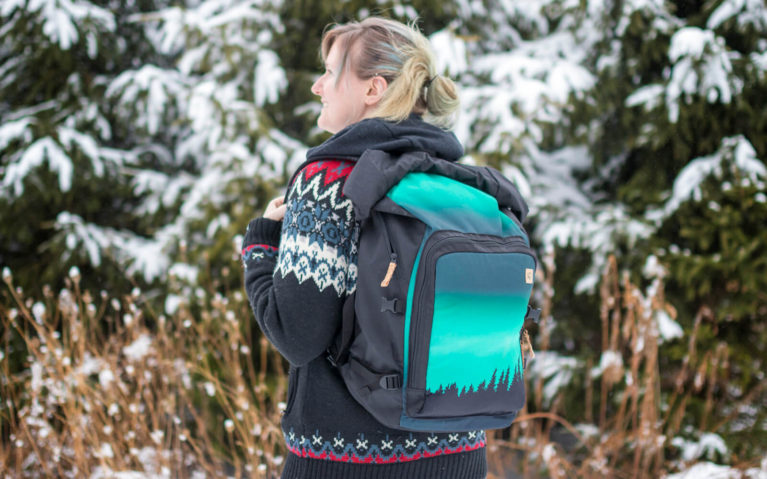
I absolutely love every product I’ve bought from tentree like this backpack!
Be Eco-Friendly When You Shop
Fast fashion is and has been a huge problem for a long time. The amount of clothing that ends up in the landfill every year is astonishing. It’s estimated that North Americans throw out over 10 million tonnes of clothing each year. Luckily there are a few ways we can help fight this. The first is by thrift shopping. I absolutely love thrift shopping not just for its environmental benefits but the thrill of the hunt. It’s also great for your wallet as you’ll be able to find big brands for a fraction of the cost. I can’t tell you how many times I’ve found North Face, Columbia and other outdoor brands for dirt cheap.
Another way to beat fast fashion is by supporting reputable companies that try to decrease their impact on the planet. One of my favourite brands for this is tentree. Not only did this company get its start in Canada but they continually make a positive impact on the world. Their clothing is made of organic cotton, hemp, and more sustainable materials. On each page for their clothing items, there’s an “eco-log” which shows how much water and waste have been saved for every item. Side note, items from companies like tentree make awesome gifts for the nature lovers on your list.
Lastly, you can take this to the next level by purchasing items made from REPREVE® Recycled Polyester. What is that exactly? It’s a fibre made of recycled materials including plastic bottles. How cool is that?! My favourite example is tentree’s Mobius backpack (pictured above) which recycles 31 plastic water bottles with every bag. You can also find shirts made from REPREVE® at stores like Mark’s in Canada.
Avoid Single-Use Plastics
This is getting easier to do but many restaurants still offer single-use plastic items. Getting into the habit of saying no to plastic straws and cutlery will make a world of difference. Especially since as of right now, over 8.3 billion plastic straws alone are polluting the world’s beaches. Some destinations have even chosen to ban plastic straws entirely, including a number of major US cities. A good rule of thumb is to request no straw before ordering your drink – that way it’s top of mind for both you and your server. If you’d still like to use a straw, a metal straw is a great alternative as you can re-use it multiple times over. Having reusable cutlery handy when you’re out at festivals, camping and more can really help too.
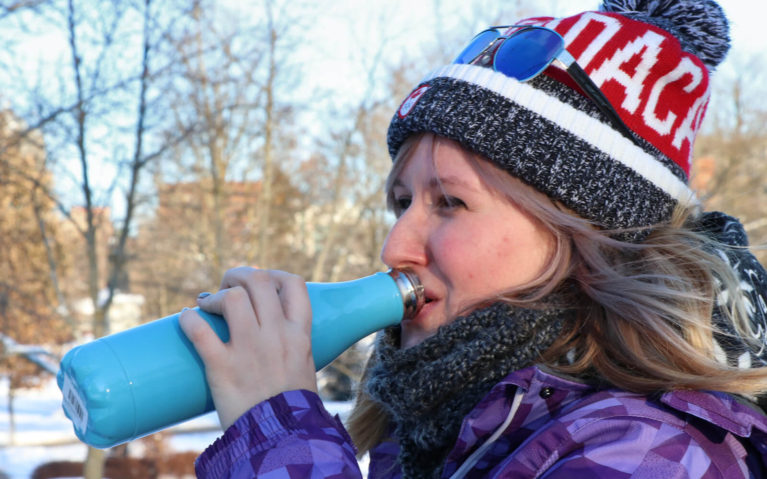
In the winter they can really come in handy if you put lukewarm water in them. That way the water won’t freeze!
How about those terrible plastic water bottles? The United States alone consumes 1500 plastic water bottles every second. Not only that but of the 50 billion bottles purchased each year, 80% of them end up in a landfill despite recycling programs. The best way to cut these awful bottles? Grab an aluminum reusable water bottle. Aluminum bottles are the best reusable option as they are most easily and efficiently recycled. I personally adore my Hydroflask bottle and would highly recommend any of their products!
Don’t forget about the plastic bags! With over five hundred billion used across the globe each year, it quickly adds up to horrific amounts of garbage that linger for thousands of years. Not only that, but crazy amounts of fossil fuels and water are needed to create them, making them bad news all around. The answer? Reusable bags. By using a reusable bag across your lifetime, you can cut up to 22,000 plastic bags. If that’s not enough incentive, here are 25 reasons to embrace reusable bags. Despite the fact that many businesses now charge for these bags, it seems as though people are happy to take that charge as opposed to buying a reusable bag. Do your part and keep them everywhere – at the entrance to your apartment, in your car, and especially when you travel. I take mine with me for groceries, souvenirs and more. They’re just so handy!
Lindsay, I f*cked up and I’ve got a plastic fork haunting me. What do I do? Hey, sh!t happens. Sometimes we forget or people don’t listen when you say no and it ends up in your bag anyway. Whenever I end up with a plastic fork or spoon, I use it as many times as I possibly can. I’ll clean it off and keep it tucked away in my purse or backpack for future use until it eventually breaks. It’s not a perfect solution, but it’s better than tossing it only to find yourself using another one two days later. The same goes for plastic bags too. If you end up with a single-use plastic item, use it multiple times until you can’t anymore.
Not convinced about the effects of single-use plastics? What about these destinations taking a stand and banning single-use plastics? How about the Texas-sized plastic glob that’s hanging out in the Pacific Ocean? See how just making one change can make an impact with this infographic:
Practice Leave No Trace
You’ve probably heard the saying ‘take only photos and leave only footprints’ – leave no trace is similar in nature but much broader. The fundamentals include leaving nature as you see it, staying on marked trails, keeping your distance from wildlife and not littering, even if it is biodegradable. Taking a rock or sand from a destination may not seem like much but if thousands of people all do it – you can imagine the impact it would have. Moving organic materials like wood from one area to another can carry parasites which could have detrimental effects on the area. The best practice is to leave everything as is, make as small of an impact as possible and always carry out what you carry in.
Unfortunately, not everyone does this and litter seems to appear more and more often. To help out the environment, bring a bag to collect garbage as you walk, hike or run. There’s even a movement called plogging where you go for a jog and pick up litter along your route. Originating in Sweden back in 2016, it has become more popular with groups in the USA, Canada, India and more organizing official meetups.
Be Aware of Where You Are (& Where You’re Visiting)
The world is our oyster but at the same time, we have a responsibility to protect it. There are destinations that are unique and rare which we must respect so these natural wonders will be around for years to come. Nature is not to be taken for granted – it is a privilege, not a right. Same with travel. That means practising leave no trace is even more important in these sensitive areas.
One example that’s close to home for me is Ontario’s Cheltenham Badlands. This rock formation is incredibly unique as its red colour comes from the iron oxide within the Queenston Shale. The rolling hills make it look as if you’ve landed on Mars. It truly is a sight to behold! Unfortunately, many visitors couldn’t treat the area with respect as they trampled all over it – some people even claiming to have seen children kicking at the soft rock, damaging it forever. As a result, it was closed for three years in order for the geology to recover.
We’re lucky enough that the area has been able to restore itself (along with the help of conservation organizations) and as such, has reopened to the public. There is now a beautiful lookout platform right beside the Cheltenham Badlands so they can be viewed without damaging the rock… as long as people don’t jump the fence. I was there just weeks after it reopened and I could already see footprints on the rock. It broke my heart that some people just can’t see the bigger picture, which is why we all need to do our part. Don’t be afraid to call someone out and educate them as to why. Some may honestly just not know while some may just be ignorant. Either way, we all need to work together to protect the land on which we live.
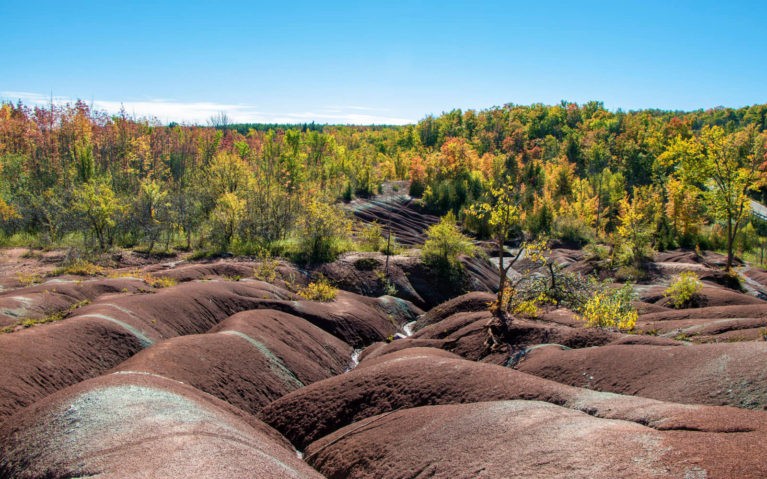
Unique landscapes may be enticing but always stay on the trails to protect delicate environments!
Avoid Popular Destinations in Peak Season (or Altogether!)
Overtourism is a hot topic these days – and for good reason. With more people not only interested in travel but having the privilege to do so, destinations are becoming overwhelmed with people. Why is overtourism bad? For a number of reasons. It leads to locals being forced out of cities due to short-term rentals increasing property prices so high that locals can’t afford it. Local infrastructure can’t support the influx of people and as such, degrades the quality of life for those who live there. Along with damage to nature, the culture of the area and its heritage, overtourism is extremely problematic.
It’s even come to the point where some popular destinations including Venice, Barcelona, Macchu Picchu, Amsterdam and more are implementing measures to combat it. Venice has barred cruise ships from entering the city’s terminal for fear of degrading the centuries-old buildings. Property owners in Barcelona have evicted locals because tourists will pay more, leading to demonstrations and protests. Macchu Picchu now limits how many people can visit the mountain top village along with what routes can be taken to get there. Amsterdam has gone as far as to analyze data via the popular I Amsterdam city card to entice people to visit attractions at times when they aren’t as busy. Their latest step has been to remove the iconic ‘I Amsterdam’ letters from their place at the Rijksmuseum. They may be gone, but not for good. Instead, they’ll tour around to lesser-known destinations so you can still get your photo – you’ll just have to work for it.
What can you do as a traveller to help combat overtourism? A number of things! If you want to visit those popular destinations, opt for off-season travel. This not only spreads tourism dollars across the year which is better for local businesses but will often mean a better experience for you and your wallet. Fewer crowds, often cheaper costs and the tranquillity of enjoying the destination as it should be. Want to take it a step further? Don’t go at all and pick a different, lesser-travelled destination. The best way to go about this is to think of why you’re travelling there. Are you going to Paris just to get a photo with the Eiffel Tower? Or are you going because you studied fine art and want to see where the art world began? …catch my drift? If you’re going to travel to popular destinations then be purposeful and smart about it.
Another big way is how to go about travelling. For many, the go-to is flying as it’s quick, efficient and for those countries that have great local airlines (ahem NOT Canada), cheap. However, the carbon footprint of flying is much greater than other modes of transportation. Sometimes it really is unavoidable, but when it is, consider slower modes of transportation. Taking a train or bus can greatly reduce this impact. The best way to decrease your travel impact? Body power! Get some exercise and walk or ride a bike as much as you can while travelling. Yes you can’t go as far and yes it does take a lot of effort, but it’s good for both you and the planet.
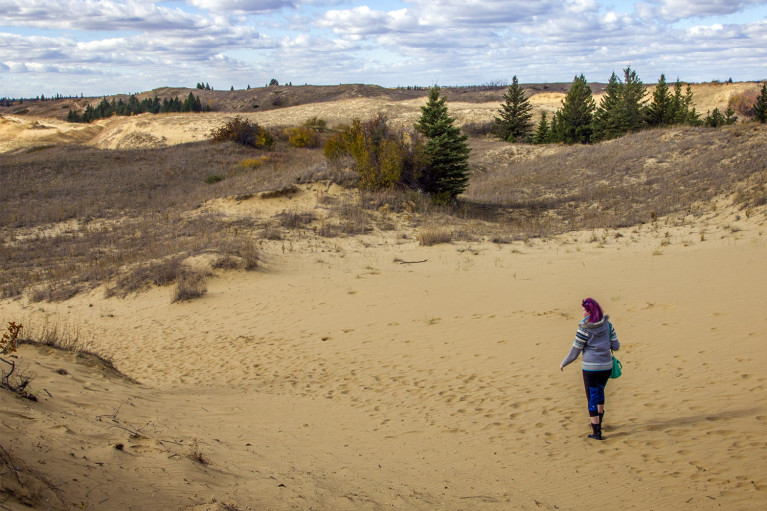
Believe it or not, I was on the trail! If you’re going to get lost anywhere, it’s the sand dunes of Manitoba. Click to read more!
Keep Your Tourism Dollars as Local as Possible
Supporting local businesses is amazing for a number of reasons. First, you’re keeping your tourism dollars in the local community which creates jobs and supports the people who live in the destination. This creates more jobs and a better economy as local artisans, shopkeepers and more can earn a better living and support their families. One of the easiest ways you can do this is by avoiding chain restaurants, cafes, etc and indulging at a local establishment. Chances are the food will be better, you’ll be happier and you’ll have a more authentic experience.
SOMETHING TO NOTE: If haggling is a given at the destination you’re visiting, don’t take the first price you’re given but also don’t go overboard. Chances are those few cents or dollars won’t affect your bottom line much but it’ll go far for the local vendors. Be aware of the value of the item so you don’t get taken advantage of but at the same time, don’t take advantage of the locals either.
While I’ve never done one myself, homestays are an incredible way to experience local culture and support it. You’ll stay with a host family and become a part of their home. Sometimes you’ll even help out with chores or contribute to the household in other ways. If that sounds like a bit much for you, bed and breakfasts are another great way to support local while enjoying a bit more privacy. Hotels still your jam? Book with companies like Kind Traveler where for a small donation to one of their vetted charities, you’ll be rewarded with exclusive deals at unique properties around the world.
Chances are when you’re travelling, you’re looking for local experiences. What better way to do that than through a local cooking class, walking tour or cultural excursion? Booking a local experience (like a walking tour with a local guide!) and avoiding big bus tours can really take your trip to the next level all while being good to the environment. There’s also the option to ask your host (if you’re staying in a B&B, homestay or even Couchsurfing) for recommendations or even if they’d be willing to take you to their favourite local haunt. I’ll never forget my trip to the Northwest Territories where my Airbnb host invited me out with his friends on my first night. I had an absolute blast and we still keep in touch! Side note – nothing beats northern hospitality. I’m not kidding. It’s one of the reasons you have to visit the Northwest Territories.
What Steps Do You Take to Be a More Eco-Friendly Traveller?
There are seriously so many ways you can be kinder to the planet while you travel, but these are some of the easiest in my opinion. It doesn’t require a full lifestyle change (but if you want to do that – hey! Good on ya!) but just by taking these simple measures, you can really make an impact. It’s about being smarter and thinking ahead about the impact your choices have. A little bit of planning can go a long way!
That being said, what are some ways you try to be a more eco-friendly traveller? Like I mentioned earlier, this isn’t a be-all-end-all list by any means, so I’d love to hear what you do. The biggest thing you can do to be a more eco-friendly traveller? Keep learning and teaching others what you’ve learned. Knowledge is so powerful and if we all take steps like these together, we’ll make a difference.
Disclaimer
This post contains affiliate links where I could receive a kickback at no extra charge to you!
Read more in IBB’s disclaimer and privacy policy.
Want to keep these eco-friendly traveller ways handy? Pin it for later!











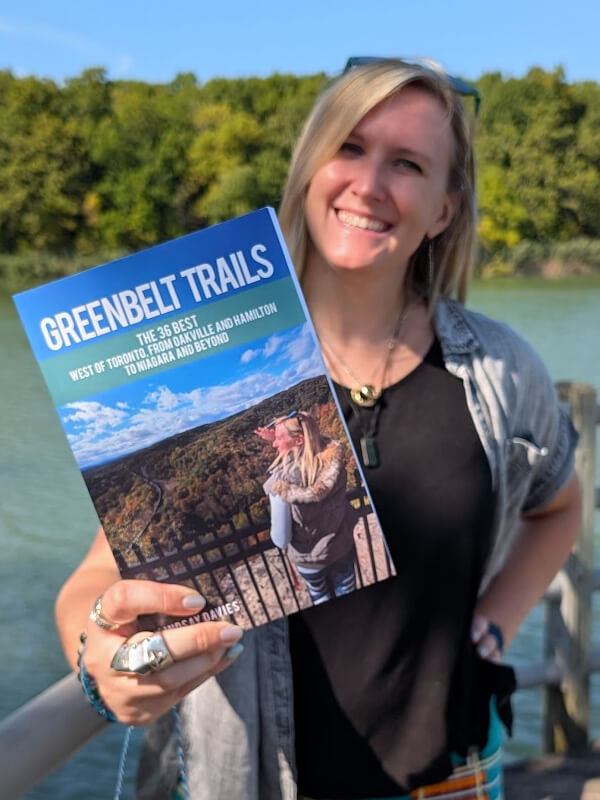


Josy A
Great post Lindsay! I try to do most of these (although admittedly I do have to fly home these days as we live so far away from our families…)
I think you are right about heading to less famous places, or visiting on the off season. To be honest, that is a win-win as I am never keen on large crowds.
Urgh. I really hope we (as in humans in general) can reverse the mess we are making of this planet. We all need to do the little things, but I honestly think the *most* important change is more structural. We need stronger laws to stop corporations from polluting, and force them to change the way they package foods/products. Things are changing, but I think it is all too slow.
Lindz author
GAH I totally missed this notification – thank you for your comment Josy! I resonate so much with this. We really need to do so much more to help save our planet. It doesn’t matter how much production happens or money companies make if there’s no damn world to house them anymore!!
Sophie van der Meulen
Love this post, you have some great tips here. I´m working on a similar post, it´s such an important subject! We can all do better
Lindz author
Thanks Sophie! It truly is such an important topic that we all need to be aware of! 🙂
Brad
Relevant and informative post, really loved it!
Lindz author
Thanks, Brad! Glad to hear it 🙂